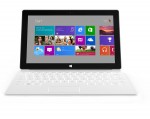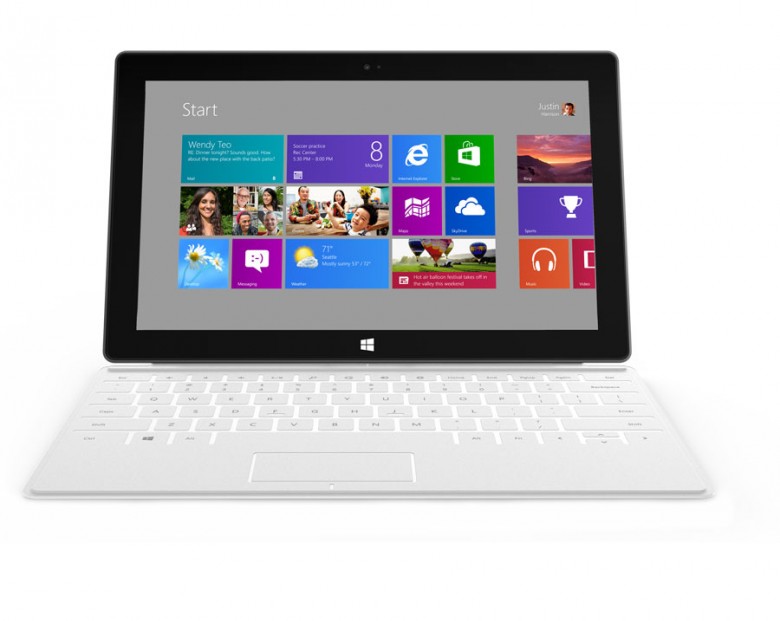Yesterday, Microsoft took the plunge into the tablet market, unveiling its Surface tablet.
The Surface is positioned to go head-to-head with Apple’s iPad.

There are two Surface models, the Surface for Windows 8 Pro and the Surface for Windows RT. As its name implies, the Surface Windows 8 Pro is the “professional” version aimed at content creators.
Microsoft has taken aim at arguably the two biggest ‘shortcomings’ of the iPad.
Lack of keyboard – Both Surface models will come with a lightweight cover that has a keyboard built in. The iPad has a virtual keyboard although there are many third-party iPad covers with an integral keyboard.
Ports – The iPad only has the 30-pin dock Apple connector port. The Surface for Windows RT will sport two USB 2.0 ports as well as a microSD port. Likewise, the Surface for Windows 8 Pro will have two USB 3.0 ports as well as a microSDXC port.
Below is a comparison the Surface models as compared to the iPad and the MacBook Air. It may seem a little strange to include the Air specs but, at various times throughout the Microsoft presentation, the Surface was called a tablet, PC and ultrabook. Arguably, the Surface for Windows RT model is poised to go up against the iPad while the more robust Surface for Windows 8 Pro is geared more to compete with an ultrabook such as the Air.
It is unclear at this time (at least to me) which is the better tablet. There are many unknowns with the Surface tablets, such as battery life and, most importantly, pricing. The release date is expected to be later this year.
And, seriously, I hope they come up with a shorter name for these, like Surface RT and Surface Pro. It’s almost as bad as MacBook Pro with Retina Display.
Feature | Surface for Windows 8 Pro | Surface for Windows RT | iPad (3rd generation) | MacBook Air |
| Operating System | Windows 8 | Windows RT | iOS 5 (iOS 6 in Fall 2012) | OS X Lion (OS X Mountain Lion in July 2012) |
| Aspect ratio | 16:9 | 16:9 | 4:3 | 16:9 |
| Depth | 0.53” | 0.36” | 0.37” | 0.68” |
| Weight | 1.99 lbs. | 1.49 lbs. | 1.44 lbs. (cellular 1.46 lbs.) | 2.38” |
| Storage | 64 GB or 128 GB | 32 GB or 64 GB | 16 GB, 32 GB or 64 GB | Flash storage – 64 GB. Configurable to 128 GB, 256 GB, 512 GB |
| Diagonal | 10.6” | 10.6” | 9.7” | 11.6” |
| Pixels | 1920 x 1080 pixels | 1280 x 720 pixels | 2048×1536 pixels | 1366×768 pixels |
| Pixel density | 139 ppi | 139 ppi | 256 ppi | 135 ppi |
| CPU | Intel Ivy Bridge | Nvidia Tegra | 1.7GHz dual-core Intel Core i5 | |
| Chip | Intel Ivy Bridge Chipset | ARM Chipset | Dual-core Apple A5X | Intel HM77 |
| Wifi | Expected (though not official) | Expected (though not official) | Yes + cellular | Yes |
| Carriers | No reference to cellular | No reference to cellular | Verizon, AT&T | Not applicable |
| Camera | Front and rear | Front and rear | Front and rear | Front |
| Battery | 42 watt-hour | 31.5 watt-hour | 42.5 watt-hour | 35 watt-hour |
| Ports | Two USB 3.0 ports,microSDXC | Two USB 2.0 ports, microSD | 30-pin dock Apple connector port | Two USB 3.0 ports, Thunderbolt port,MagSafe 2 power port |
| Covers | Magnetic cover that doubles as a keyboard; built-in kickstand | Magnetic cover that doubles as a keyboard; built-in kickstand | Magnetic cover ($39) that doubles as a kickstand | Clam shell |
| Keyboards | Touch Cover and Type Cover | Touch Cover and Type Cover | Virtual | Integral |
| Pricing | TBD | TBD | $499 (16 GB wi-fi) to $829 (64 GB wi-fi + cellular) | Starting at $999 |

Comments are closed.